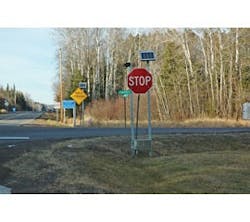Rural, two-way-stop controlled intersections present a significant challenge for traffic safety.
For the 10-year period of 2002 to 2011 in Minnesota, 43% of all intersection crashes occurred at unsignalized intersections. However, for this same period, 65% of fatal and serious-injury intersection crashes occurred at unsignalized intersections. Rural, two-way-stop intersections accounted for 76% of these fatal and serious-injury intersection crashes. Right-angle-type crashes accounted for the largest percentage, by crash type, of fatal and serious-injury crashes at rural, two-way-stop intersections. The problem is clear: The focus of intersection safety needs to be addressing right-angle crashes at rural, two-way-stop intersections. Research in Minnesota suggests that approximately 60% of right-angle crashes at rural intersections involved a driver that came to a stop and then pulled out in front of a vehicle on the major road, whereas 26% of these crashes involved a driver running the stop sign. This suggests strategies should focus on assisting drivers on the minor road in judging appropriate gaps. One of these strategies is to provide an automated real-time system to inform drivers of the suitability of available gaps for performing a turning movement.
An emerging technology to treat rural, two-way-stop intersections is new rural intersection conflict-warning systems that are based on intelligent transportation systems (ITS). The Minnesota Local Road Research Board (LRRB) funded a research project to design and implement in the field a rural intersection conflict-warning system. Named the ALERT System (Advanced LED WaRning System for rural InTersections), it aggressively adopts recent ITS technologies available as commercial off-the-shelf products. These include LED integrated signs, wireless actuation and communication, nonintrusive vehicle-detection sensors and renewable energy via batteries and solar panels.
1 and 2
The goal of the project was to improve intersection safety and create a low-cost system that is easy for local agencies to install, operate and maintain. The project consisted of two phases incrementally improving the system design, ALERT-1 and ALERT-2. The ALERT-1 system was documented to be effective in reducing vehicle speeds on the major road and increasing wait times before completing a turning movement and eliminating roll-throughs for vehicles on the minor road when there was a conflict at the intersection. However, an increase in roll-throughs by vehicles on the minor road was observed when there was no conflict at the intersection.
This observation presented a unique dilemma to the research team. In effect, drivers were treating the system as a de-facto traffic signal. Through discussions with colleagues, this behavior was hypothesized but never actually observed. For the ALERT-2 system, it was determined the best solution was to add a feature to the system to mitigate this effect. This feature was dynamic blinker stop signs that were activated when a vehicle was detected at the respective stop-ahead warning sign. This modification was based on the study that flashing LED stop signs have been shown to be effective at reducing roll-throughs. Other improvements were incorporated into the ALERT-2 system to improve the overall system reliability, in particular, battery-power support and reliability of sensors and system design for easy maintenance.
Major and minor
The ALERT system was installed at a rural, two-way-stop intersection near Duluth, Minn. The speed limit on both roads was 55 mph. The annual average daily traffic was 970 vehicles per day for the major road and 570 vehicles per day for the minor road. The ALERT system layout was composed of three dynamic flashing warning signs, two dynamic flashing stop signs and six detectors.
On the minor road, a vehicle was first detected at the stop-ahead warning sign. This detection activated the flashing stop sign for a fixed time period based upon the typical deceleration of a vehicle to a stop condition. Once the vehicle arrived at the stop sign, another detector activated the flashing cross-traffic warning sign for the entire time the vehicle was detected at the stop sign. On the major road, a vehicle approaching the intersection was detected and activated the flashing vehicle-approaching warning signs for a fixed time period based upon the typical time for that vehicle on the major road to arrive and pass through the intersection.
Crash data was not used in the analysis because there were no reported crashes in the before period. Instead, the research analyzed four surrogate metrics: The first was vehicle speeds on the major road; second was the wait time for vehicles on the minor road at the stop sign; third was the percentage of roll-throughs for vehicles on the stop-controlled minor road; and fourth, a mail-in survey of local residents. Video cameras were used to observe and measure driver behavior on the major road and at the intersection. Video data was collected for 42 days before the ALERT system was installed and 259 days after the installation.
Watching movements
Speed, wait time and roll-throughs were all analyzed during conflict and nonconflict times. A conflict was defined as when a vehicle was stopped on the minor road at the stop sign and a vehicle on the major road was approaching the intersection. A nonconflict was defined as the absence of either a vehicle stopped on the minor road at the stop sign or a vehicle on the major road approaching the intersection, but not both.
The speed analysis was used as a surrogate measure of a driver’s recognition of a potential conflict at the intersection ahead due to a vehicle stopped on the minor road at the stop sign. A decrease in these vehicle speeds is assumed to correlate to an improvement in conflict recognition whereby the driver attempted to increase the amount of time in which to react to perform a successful evasive maneuver if necessary. The average speed for vehicles on the major road approaching the intersection before the ALERT system was installed was 51.9 mph. After the ALERT system was installed, the average speed of these vehicles was 51 mph.
Distinguishing between conflict and nonconflict cases after the installation, the average speed of vehicles on the major road during a nonconflict was 51.8 mph, but during a conflict was 47.9 mph. This means the ALERT system was able to reduce the average speed of vehicles on the major road approaching the intersection by 3.9 mph (51.8 mph to 47.9 mph) during a conflict.
The wait-time analysis was used to determine if there was a change in the amount of time that a driver was stopped on the minor road at the stop sign when there was a vehicle on the major road approaching the intersection. This analysis was used as a surrogate measure of a driver’s recognition of an acceptable gap. A longer wait time during a conflict is assumed to correlate to an improvement in gap recognition. The average wait time before the ALERT system was installed was 2 seconds. After the installation, the average wait time was 2.5 seconds during nonconflict periods and 3.9 seconds during conflict periods. This means the ALERT system was able to increase the wait time for a driver stopped on the minor road at the stop sign when there was a vehicle on the major road approaching the intersection by 1.9 seconds (2 seconds to 3.9 seconds).
The roll-through analysis considered all three turning movements of vehicles stopped on the minor road at the stop sign and then proceeding into the intersection. A stop was defined by a vehicle that came to a complete stop and also a vehicle whose relative velocity was below an established threshold that was determined by the research team, referred to as a “rolling stop.” All other vehicles were defined as a roll-through. This analysis was used to assess whether the ALERT system had a negative effect on a driver’s compliance with the stop sign during nonconflict periods and, conversely, if drivers had a better recognition of an unacceptable gap during conflict periods. If the percentage of roll-throughs increased during nonconflict periods, it is assumed to correlate to drivers using the ALERT system as a de-facto traffic signal. Conversely, a reduction in the percentage of roll-throughs during conflict periods also is assumed to correlate to an improvement in gap recognition. Before the ALERT system was installed, the percentage of roll-throughs for all vehicle movements from the minor road was 28%. The largest percentage of roll-throughs occurred for right-turn movements and the smallest percentage occurred for left-turn movements. After the ALERT system was installed, the percentage of roll-throughs was 16% during nonconflict periods and 1% during conflict periods. Roll-throughs were nearly eliminated during conflict periods. The largest percentage of roll-throughs during the nonconflict period occurred for right-turn movements and the smallest percentage occurred for through movements (a flip from the before period). There effectively was no difference in the percentage of roll-throughs during conflict periods by the type of turning movement.
Finally, a mail-in survey was sent to residents living within a 2-mile radius of the study intersection. A total of 206 surveys were sent out and a total of 119 were returned for a 58% response rate. The first question asked was how frequently they drive through the intersection. Most of the respondents, 89%, drive through the intersection at least once per day. The second question was broken into four statements and asked the respondent to assess how strongly they agreed or disagreed. For the final question, a cumulative response of 87% ranked the effectiveness of the system as excellent (52%) or good (35%).
All positive
In conclusion, the evidence suggests this system was able to effect a positive change in driver behavior for both the major road and minor road during a conflict. In the NCHRP Report 500, Volume 5, which lists safety strategies for unsignalized intersections, two of the safety strategies are assisting drivers on the minor road in judging appropriate gaps and reducing the operating speed of vehicles on the major road. It appears the ALERT system was able to accomplish both of these objectives.
However, it should be cautioned that there are still questions and concerns surrounding the behavior of drivers on the minor road when there is no conflict with a vehicle on the major road. It appears drivers are blending the sign definitions of the Manual on Uniform Traffic Control Devices whereby the driver treats the stop sign as a warning sign and the vehicle-approaching warning sign as a regulatory sign. However, even in the worst-case scenario during nonconflict periods, the roll-through percentage is lower than before the ALERT system was installed (16% vs. 28%). It is recommended that future human factors research be performed on this observed phenomenon.
For further reading, the full research report can be accessed from the Minnesota LRRB website at www.lrrb.org. The report was expected to be published on this website by spring 2014. A video summarizing this research project is available for viewing at
mntransportationresearch.org.
Acknowledgement
The authors would like to thank Rob Ege of Minnesota Department of Transportation (MnDOT) District-1 and Alan Rindelws of MnDOT Research Service for valuable input in the sign system design process.



